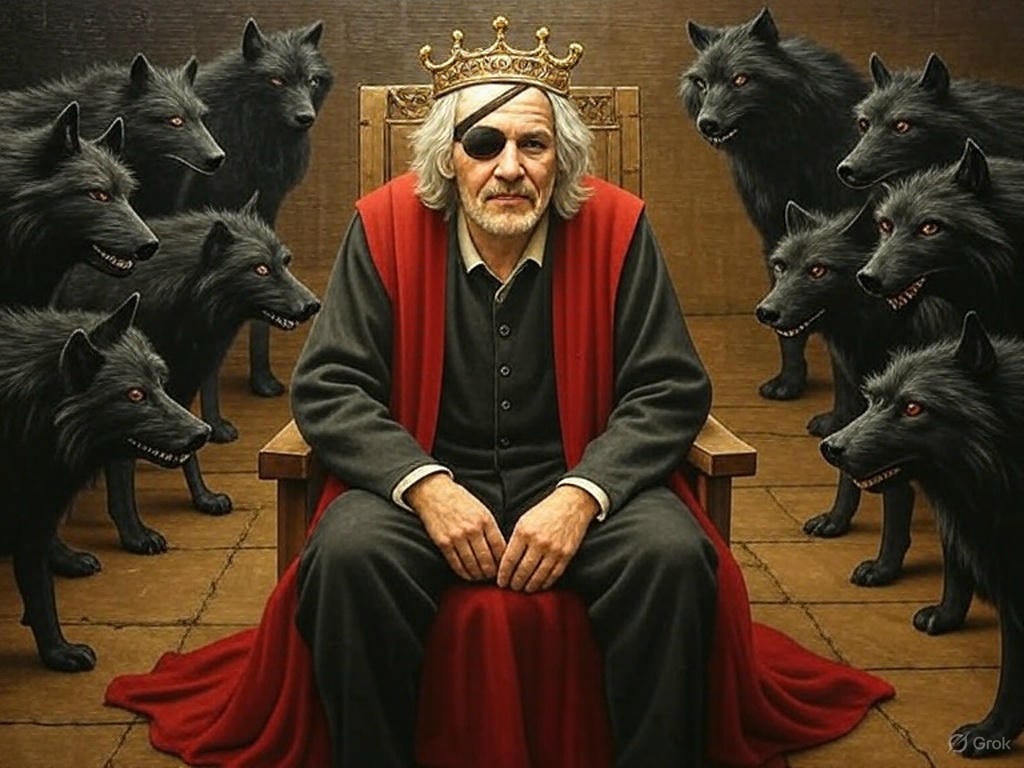The King is Dead. Long Live the King: A Marketer’s Survival Guide to Google's Decline
The days of dumping cash into Google Ads and calling it a day are coming to a close
Google could die.
It always seems impossible for the king to fall—but it’s happened many times in history.
Even in American commerce, GE, Xerox, Blackberry went from industry leaders to the graveyard.
Google has seen invincible for decades.
But that’s not the natural state of things—this concentrated media landscape, where a few companies control the ad world, isn’t normal—it’s a blip in history1.
Recent antitrust rulings are shaking things up, hinting at a future where the media might fracture again, like the days of local papers and mom-and-pop radio stations.
If you’re a marketer, the days of dumping cash into Google Ads and calling it a day are coming to a close.
Instead of bemoaning changes, it’s time to get back to the roots of marketing: creating real behavior change—sales, loyalty, buzz—for the least investment possible.
In this post, we’ll unpack:
how we got here
what’s changing
how to adapt by returning to fundamentals of old-school marketing.
Let’s a-go
How We Got Here: How Media Giants Grew
Once upon a time, media was a messy, fractured landscape.
Every town had its own newspaper, radio station, or quirky TV channel, each with its own practices, audiences, and pricing.
Marketers had to understand audience segments—crafting ads for the local diner’s jukebox or the county fair’s banner.
It wasn’t easy, but it forced creativity and true understanding of the audience needs.
Then, the world shifted.
By 1983, 50 companies controlled 90% of U.S. media.
By 2011, it was down to 6.
The 1996 Telecommunications Act was a big spark, loosening rules and letting corporations merge and grow uncontrollably.
Then the internet exploded.
Google and Meta (f/k/a Facebook and Instagram) turned digital advertising into their personal fiefdoms.
These two alone suck up over 50% of U.S. digital ad spend.
For marketers, it’s been a godsend: massive reach, the vendor manages targeting, and you don’t need to get elbow deep to understand your audiences.
This consolidation’s killed diversity.
Algorithms amplify what’s already hot, drowning out smaller voices.
And this algorithmic decision-making has made marketers lazy.
Why sweat over a clever billboard—by *gasp* visiting somewhere in person and talking to people—when you can A/B test a Meta ad in 2 days from your laptop?
But leaning so hard on a few platforms has risks, especially when the legal ground’s starting to quake.
Recent Antitrust Developments: The Giants Start to Wobble
The tech giants’ grip is loosening, and regulators are swinging.
In August 2024, a U.S. court ruled Google broke antitrust laws by locking down online search with conspiratorial deals—like paying billions to be the default on phones and browsers.
Then, in April 2025, another judge slammed Google for running an illegal monopoly in online ad tech, putting its $31 billion ad machine in the crosshairs.
The DOJ even floated spinning off Chrome in November 2024, which could crack Google’s stranglehold on the ecosystem wide open.
Somehow all of this news doesn’t seem to affect their stock price very much. How? Who knows
Meta’s catching strays too.
In April 2025, the FTC launched a trial accusing Meta of building a social media empire by aggressively buying up threats like Instagram and WhatsApp.
If the FTC wins, Meta might have to carve off those platforms, shaking its $160 billion ad business to the core.
What’s this mean? The media world could splinter.
New players might flood in, and the ad market could start looking like the chaotic, fragmented days of old.
For marketers, it’s a warning: the platforms you’ve bet on might not be bulletproof much longer.
Time to rethink the playbook—and return to fundamentals!
Returning to Marketing Fundamentals: The Hard-Boiled Playbook
The golden rule of marketing hasn’t changed: create the biggest behavior change—sales, loyalty, buzz—for the least investment.
It’s simple, but not easy, like telling someone to “eat less” to lose weight.
The trick is cutting through the noise and focusing on what drives results.
Here’s how to channel the no-nonsense wisdom of old-school marketers like David Ogilvy and Claude C. Hopkins to thrive in a shifting landscape:
Focus on Sales, Not Vanity Metrics
Forget likes, impressions, or “brand awareness” that doesn’t pay the bills. Your job is to move the needle—conversions, customer acquisition costs, lifetime value. Old-school marketers knew this.
Ogilvy said, “The more informative your advertising, the more persuasive it will be.”
Every campaign should answer: “Does this make people buy?”
How to make it happen:
Measure what matters. Track conversion rates, not just clicks. If your ad spend isn’t turning into revenue, it’s a hobby, not a strategy.
Test ruthlessly. Run small experiments to see what works—different headlines, offers, or channels. Claude C. Hopkins was a testing fiend, and it made him a legend.
Set clear expectations. Before launching, line out what success would look like. If the math doesn’t add up (investment < return), rethink it. Include ad spend, employee time, and opportunity costs—no fudging.
Build a Unique Brand Identity
Chasing private capital or platform algorithms often leads to bland, safe branding.
But in a splintered media world, standing out is your superpower.
Companies like Darn Tough Vermont (socks that last forever) or King Arthur Baking (baking tutorials for all) don’t dilute their vibe for investors—they double down on what makes them unique.
Here’s how:
Own your niche. Define your brand’s personality—goofy, rugged, helpful—and stick to it. Looking like everyone else means… that you look like everyone else.
Skip the VC trap. Don’t water down your identity just to look “acquirable.” A strong brand drives sales, not just boardroom applause.
Spread Your Bets Across Channels
The days of “just Google it” are fading.
A fragmented future means you need to show up where your customers are—local radio, niche podcasts, or that weird new social app.
To allocate your budget wisely, consider the Kelly Criterion.2
It suggests betting a fraction of your resources proportional to your edge (expected return) divided by the odds (variance).
For marketers, this means putting more budget into channels with proven ROI but never going all-in on one, ensuring you balance risk and reward across experiments.
You’ll reach new audiences and dodge the risk of a single platform’s collapse.
Get started with:
Local media. Sponsor a community event or run a radio spot. A coffee shop could own the morning commute with a memorable slogan for a local running group—that same slogan wouldn’t scale well, but the sales are still real locally
Podcasts. Listeners trust hosts. Find a show your audience loves and sponsor it—bonus points for niche topics.
But don’t expect it to perform well on performance marketing!
Emerging platforms. TikTok, Discord, or whatever’s next—jump in early. Small brands can use (temporary) inefficiencies in the market to make outsized gains.
Test and learn. Start small, track results, and scale what works. If a channel flops, don’t hesitate to cit it.
This isn’t about chasing trends—it’s about being pragmatic.
Every dollar you spend should justify itself with results.
If it doesn’t, stop.
That’s the fundamentals mindset: focus on what works, ditch what doesn’t, and keep your eyes on the prize—sales.
Conclusion.
The media landscape has the opportunity to fracture, and marketers need to be ready.
The concentrated world of Google and Meta was a historical fluke, and with antitrust hammers dropping, we’re likely headed back to a fragmented future.
That’s not a threat—it’s an opportunity.
By embracing the golden rule of marketing—biggest impact, least investment—you can outsmart the chaos.
Ditch the vanity metrics, build a brand that’s identifiably, and spread your bets across channels.
The old-school marketers, with their relentless focus on results, would nod in approval.
Here’s your to-do list:
Check your metrics. Are you tracking sales impact or just clicks? Fix it.
Define your brand. Write down what makes you unique—three words max.
Test a new channel. Pick one—local paper, podcast, TikTok, whatever—and run a small campaign.
Stay sharp. Watch your landscape, tweak your plan, and never stop testing.
Don’t be afraid.
It is sometimes better to abandon one's self to destiny—Napoleon
The media’s shifting, and the marketers who know how to observe and react to changes will win the future.
Be one of them
Physical production is very different—and monopolies or duopolies are the default there—the extremely high CapEx for starting a physical production company or logistics is insurmountable in most areas. That should not be true for advertisers or media networks.
A formula used by investors (and gamblers) to maximize long-term growth while minimizing total loss





